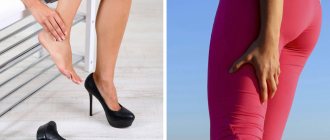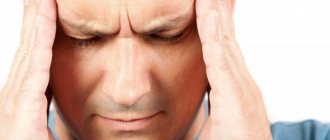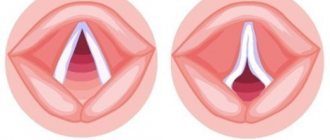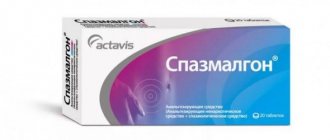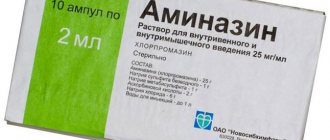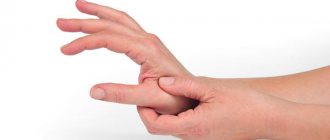How best to relieve muscle tension during neurosis: tips – Depressed
In order to understand how to relieve muscle tension during neurosis, you need to understand what kind of disease it is. Neurosis is a disease that occurs due to a disorder of the central nervous system.
Why do muscles tense up during neurosis?
A person under stress experiences anxiety, rapid heartbeat, and fear; Against this background, muscle tension may occur. For example, in case of danger, muscle tone and contractility increase. This causes an increase in the speed of muscle work and increases the physical strength of a person.
Neurosis can cause cramps and constant tension in the body if fatigue and irritability are not reduced. Intramuscular nerves may become pinched as a result of muscle stiffness.
How to relieve muscle tension during neurosis
An increase in muscle tone can manifest itself as stiffness of one or more muscles (when it is completely impossible to relax it) or as weakness, muscle hypotonia.
The applied therapy for the treatment of these phenomena:
- Soft, gentle massage.
- Warm bath with essential oils.
- Swimming in the pool.
- Cold and hot shower.
- Acupuncture should be performed by experienced doctors. It is not recommended to do it yourself.
When a person relaxes, muscle stiffness will decrease.
Drug treatment
Drug treatment should be carried out if methods without the use of drugs have not brought results. Treatment is carried out exclusively with the help of specialists. The drugs have a strong effect on the central nervous system; precise dosage must be observed.
Drug treatment may be prescribed if muscle twitching occurs, which occurs due to disruption of the nervous system. For neuroses the following may be prescribed:
- Sedatives (infusion of valerian, motherwort or peony).
- Tranquilizers. They are prescribed for the presence of phobias and fears. Nausea and drowsiness may occur while using these medications. Exceeding the dose is prohibited, as this leads to general weakness of the body.
- Antidepressants. They are sold strictly according to a doctor's prescription and relieve stress and anxiety.
- Multivitamin complexes.
- Neuroleptics (antipsychotics).
Psychotherapeutic techniques
There are several psychotherapeutic methods. Cognitive behavioral therapy may be used to help understand the causes of stress reactions.
Adaptability therapy is also used, during which the patient adapts to stress, which leads to relief from neurosis.
Through meditation, the patient can get rid of fears.
Hypnotherapy will give positive results.
Lack of sunlight can provoke muscle neurosis in people working indoors. Light therapy is used for treatment.
Physiotherapy
Physiotherapy is based on the use of such factors:
- cold and heat;
- water and ultraviolet radiation;
- electric current and magnetic field.
To carry out the procedures, use:
- Darsonvalization.
- Electrical stimulation.
- Electrophoresis.
- Electrosleep.
- Sharko's shower.
- Hydromassage.
- Circular shower.
Physiotherapy will help:
- eliminate muscle spasm;
- remove cramps;
- strengthen blood vessels;
- numb.
Effective treatment results with this method appear after 4-5 procedures.
Massage
For neuroses, massage is useful because of its calming properties. Soreness also decreases, muscle pain gradually recedes. Recommended massage:
- faces;
- collar area;
- backs;
- lower extremities;
- chest;
- belly;
- hands
Acupressure will also be useful.
When massaging, strong pressure is contraindicated. With proper massage, patients get rid of headaches, tinnitus, and dizziness.
Exercises
People who suffer from muscle stiffness are recommended to do exercises 2-3 times a week. Before starting exercises, you need to do a warm-up. Repeat each action 5-10 times:
- Standing straight, tense your arm, then relax the muscle and lower your arm. Repeat with the other arm, legs, neck.
- Raise your shoulders, then lower them and pull them back.
- Standing on all fours, bend your back, then bend upward as much as possible.
- Sitting on a chair, stretch your legs parallel to the floor. Hold this position and then place your feet on the floor.
- With your feet slightly turned inward, bend over and touch the floor with your hands.
In addition to exercise, yoga and physical therapy classes are beneficial.
Dear readers! We strongly recommend that you consult a doctor before taking medications or self-medicating. There are contraindications.
Source:
How to relieve symptoms of muscle tension due to neurosis
Daily psycho-emotional stress, as well as stress, negatively affects people’s well-being. They can provoke various internal diseases. Therefore, every person needs to know how to relieve muscle tension during neuroses. There are many methods - the doctor will tell you the best options after the examination.
Causes
Each of the neuroses that arise in a person is a consequence of a high concentration of stress hormones, which are produced in the human body as a response to external aggression.
Nature provides such a mechanism only for real danger - the threat of physical violence.
Meanwhile, the modern rhythm of life is accompanied by constant tension in the body due to moral dangers - intellectual overload, holding grievances against people around us.
The stress hormone does not have time to be completely utilized, and nervous spasms appear:
- the brain receives a signal about a threat from the outside;
- it is necessary to prepare the body to repel an attack - imaginary or real;
- the hormonal glands receive a command to increase the need for biological active substances;
- a new portion of stress hormones enters the bloodstream;
- the muscles become toned - for the fight.
When faced with daily moral overload, stress disorders, or monotonous, monotonous work, tension in the abdominal or shoulder girdle muscles leads to a deterioration in well-being. The problem becomes widespread and requires medical intervention.
Symptoms
With nervous tension, symptoms do not appear immediately - signs of muscle neurosis appear in response to a chronic, prolonged stay in a state of stress.
At the beginning, people notice periodic, local tingling in a certain part of the body, or numbness in it. With this “bell”, muscle overstrain makes itself known.
With timely provision of medical assistance, it is possible to quickly cope with such a health disorder.
If the psychological state does not improve - the situation remains emotionally unstable and difficult for a person, then emotional tension is transformed into muscle tension. Its symptoms:
- myofascial pain – a person accurately indicates the most problematic area;
- burning with tingling gradually increases in intensity of manifestations;
- the level of anxiety and nervous excitability increases;
- when the neck muscles are overstrained, headaches appear - diffuse, dull;
- various problems with sleep appear - with falling asleep, or intermittency, as well as a feeling of weakness in the body in the morning;
- if the facial muscles become tense, then facial expressions are distorted - involuntary twitching of its different parts;
- on the part of the cardiovascular system, manifestations will be in the form of tachycardia or cardialgia - pain in the heart muscle when muscles tense in the diaphragm area.
In a severe mental state, tension in the head with neurosis alone does not end the matter - convulsions and epilepsy form. Treatment tactics will require a comprehensive and long-term approach.
How to relieve muscle spasm
There are many recommendations and useful tips to relieve nervous tension in the muscles. Most of them are based on a reflex change in the nerve innervation of muscle fibers.
So, if possible, it is better to completely stop communicating with those people who cause a lot of unpleasant emotions in a person - colleagues, boss, relatives.
Of course, this step is radical and requires the application of certain efforts - dismissal from work, divorce from your spouse.
Less “extreme” ways to relieve muscle tension:
- prepare a soothing tea, for example, with chamomile, lemon balm or valerian and a drop of honey - drink in small sips, while still warm;
- turn on your favorite music and enjoy it until you feel like your muscles have relaxed;
- completely turn off all appliances, close the curtains and lie on the sofa with a wet cold towel on the back of your head - 15–20 minutes is enough to relieve mild tension;
- light an incense stick with your favorite scent and sit in silence;
- For those who are used to actively dealing with stress - how to relieve tension in the head, the best option seems to be a long walk in the nearest park or a visit to the pool.
Each person chooses for himself how to deal with muscle tension due to neurosis - just postponing events for a certain period of time is not worth it. Otherwise, medication will be required.
Massage for muscle strain
An obligatory component of complex therapy, how to relieve tension in the body during neurosis, is one of the massage techniques. The main movements are soft, stroking pressure. Tapping and pinching are unacceptable. It is recommended to perform the procedures in specialized rooms, where an experienced specialist, even with a cursory examination, will identify tense muscle areas - blocks.
Objectives of massage:
- reduce the influence of the autonomic nervous system;
- restore the patient’s psycho-emotional state;
- improve sleep;
- relieve hypertonicity of muscle groups;
- restore metabolic processes in tissues;
- increase lymph flow and blood circulation.
However, massage for neurosis is not always possible. Absolute contraindications are hyperthermia or severe psycho-emotional disorder with hysteria.
At home, it is permissible to perform self-massage - use soft stroking and pressure to knead the tense muscles of the back of the head, neck, face, and limbs. This will reduce the negative impact of stress and restore the emotional background. Whereas to relax your back muscles, it is better to use the services of a professional massage therapist.
Water treatments
Water procedures are excellent for relieving muscle tension during neuroses. They can act as an independent method of treatment, or be part of a complex of measures.
So, a warm bath with the addition of essential oils - for example, eucalyptus, fir or rosemary, mint - allows you to relax as much as possible and eliminate muscle tension. In addition, it restores blood circulation due to its indirect effect on blood vessels and improves skin respiration.
Another popular water procedure is a contrast shower. It is recommended to be taken for many diseases, including nervous disorders and disruptions in the vegetative-vascular system. Charcot's douche is considered the most popular and useful.
However, at home you can resort to a similar method of relieving muscle tension.
However, a number of diseases - tuberculosis, skin infections, as well as tumors and cardiovascular failure, will be restrictions on water treatment procedures.
Drug therapy
In case of a severe reaction to stress and the absence of positive dynamics in non-drug measures to relieve muscle tension - various cramps and myalgia, the specialist will recommend special medications. They are selected from the following subgroups:
- tranquilizers – Sibazon, Dormikum, Phenozepam;
- antidepressants – Sertraline or Paroxetine;
- anticonvulsants – Finlepsin, Rivotril, Epilim;
- neuroleptics - Sonopax, Melleril, Eglonil.
Each subgroup has its own advantages, as well as restrictions on admission. Therefore, they are prescribed as a course only by a doctor. Self-medication is absolutely unacceptable.
Source: https://glpni.ru/lekapctva/kak-luchshe-snyat-myshechnoe-napryazhenie-pri-nevroze-sovety.html
Stress lives in the back
Everyone knows that almost all diseases are caused by stress. But we would like to talk more specifically about how your experiences most often affect your body and health.
Stress is most often felt most strongly in the back, which brings with it a bunch of unpleasant problems: pain in the neck, under the shoulder blades, shoulders...
Alas, such pain is very difficult to get rid of due to the fact that we do not control our body and ourselves create new muscle tension, and therefore pain.
So, let's start in order.
- Where does stress live?
- What to do
Where does stress live?
We are sure that every person in the world is nervous at least once a day. Do you know exactly what is happening in your body at this moment? No? Then we will explain to you:
- our nervous system is divided into central , which consists of the brain and spinal cord, and peripheral , which includes somatic and autonomic. The somatic nervous system controls muscles and can be controlled by conscious mental effort.
- That is, we can turn our heads in the direction that interests us, both consciously (because we ourselves decided and wanted to do so), and “bypassing” thinking - we were attracted by a sound / something seemed, and the brain considered it necessary to turn its attention to it . The autonomic system controls the “automatic” functions of the body - heart rate, body temperature, blood pressure, respiratory rate, digestion and others.
- In turn, this system is also divided into 2 others: sympathetic and parasympathetic . It is these two systems that are responsible for the stress and relaxation reactions. They balance each other and determine the functioning of the body.
- The sympathetic nervous system “turns on” when we are under stress, the parasympathetic nervous system acts as a switch, a brake, helping us to relax and turn off the stress reaction. All reactions and processes occurring in the body at the time of stress are clearly predetermined and controlled by the system: in us your heart rate increases due to special stimulation from the body and from the release of adrenaline by the adrenal glands, active salivation begins, and bladder activity is suppressed. The system forces your entire body to mobilize all available energy resources to make you more alert and ready for action. In addition to the above, the liver releases fat and sugar into the blood, which serve as fuel. Breathing becomes deeper to allow more oxygen to reach the heart. Heart rate increases to allow oxygen, fat, and sugar to travel faster to the muscles and brain. Stress hormones such as adrenaline and cortisol help your muscles and brain use this energy more efficiently. As a result, you are ready to overcome any obstacles. The “fight or flight” response is activated, and our entire body is prepared, thanks to the sympathetic system, ready to “fight” or “escape . Therefore, the muscles tense, we are preparing for active actions! It does not matter whether you need this action at all: this reaction does not distinguish between the stress of being attacked by a predator and the excitement of a conversation with an angry boss - the body will behave the same in both cases. Of course. , there are also other reactions, for example, the reaction of care and friendship, when you begin to protect other people in a stressful situation, or the goal reaction when you urgently need to solve a problem. But when you are scared or angry, worried, do not understand what is happening — the primitive man awakens in you and hello, “fight or flight”!
- Recovery from stress does not happen instantly - it is a process that takes some time. In the first few hours after a severe stress reaction, the brain rewires itself, remembering and assimilating the experience. During this time, the activity of stress hormones increases in the areas of the brain responsible for learning and memory. The brain processes the experience, which is why you can't stop thinking about what happened. During the recovery process, a person often experiences strong emotions. Energy is still bubbling inside him, and he is too excited to calm down right away. After stress, you may feel fear, shock, anger, guilt, or sadness. But you may also feel relief, joy or gratitude.
What does the back have to do with it? The fact is that during times of stress, a person often unconsciously and uncontrollably tenses his muscles. At that stage, this seems like a good and correct strategy to the body. Monitor yourself or other people during periods of nervous experiences.
We raise our shoulders, as if trying to cover our neck, while straining it, often freezing in an uncomfortable position, not feeling it due to the rush of hormones and blood. All this creates triggers , muscle clamps, which then cause pain.
Constant tension in the muscles can lead to fibromyalgia (a form of damage to extra-articular soft tissues, characterized by diffuse musculoskeletal pain and the presence of specific painful points or points of increased sensitivity, determined by palpation) and complex regional pain syndrome.
Impetuous, unprepared muscle contractions, incorrect body position against a background of anxiety, depression, sleep disturbances, insomnia, and a stream of obsessive thoughts cause acute overstretching of the muscle, followed by convulsive spasm and pain.
In some people with PTSD, the respiratory muscle contractile apparatus is constantly overloaded, resulting in chronic respiratory muscle spasm!
But there is nothing good about muscle tension either - when the process becomes chronic, it ends in myofascial pain syndrome!
After a stressful situation, the best thing to do is to warm up thoroughly, get the blood flowing and thus relax tense muscles . But who does it? Units! Meanwhile, if stress is frequent, then even a spasm of the cervical-collar area occurs, which reduces blood supply to the head by up to 20%!
Moreover, there is pain in the neck and head, especially in the occipital region or migraine pain, covering half of the head; less often - pain in the temporal region or in the face, simulating trigeminal neuralgia.
Pain in the temporal region is often associated with chronic tension of the muscles that compress the jaw: in moments of unpleasant experiences, a person automatically, without noticing it, clenches his teeth (such a “stressful” habit can lead to an unpleasant condition called “temporomandibular joint syndrome”).
“Tension headaches” often manifest themselves as a sensation of a tight “helmet” being placed on the head and painfully squeezing it (in medical language there is even a figurative expression “neurasthenic helmet”).
Tension of the muscles of the neck and back of the head not only leads to pain in this area, but can also be accompanied by dizziness and other very unpleasant symptoms. Often the appearance of pain and heaviness in the cervical-occipital region coincides with an increase in blood pressure.
Important Cause of Sugar Addiction: Check Your Neck
But what can you do about it? How to get rid of the feeling of an exorbitant burden lying on our fragile shoulders?
What to do
So, let's start with the most important and main treatment for you: movement ! Yes, everything is so banal, yes, everything is so simple. Even the most expensive ointments, tablets and massages will be powerless if you do not engage in exercise therapy.
We can endlessly list the advantages of movement:
- Dosed exercises balance blood sugar levels and relieve muscle tension, which occurs in constantly nervous people. This allows you to cope with anxiety, contributes to the outburst of accumulated aggression outside and without harm to relationships.
- During exercise, the body produces endorphins - chemical compounds similar in structure to opiates, which are naturally produced in the neurons of the brain.
- Physiotherapists explain the beneficial effects of sports during stress by the fact that physical activity causes an active flow of oxygen to all organs of the body, including the brain.
Korchoe, don’t be lazy and study, the efforts you expended will come back to you a hundredfold! But let's be more specific about how to get rid of pain. Your task is to get rid of trigger points in the muscles that are causing back pain.
The following is a quote from our article Why has it become fashionable to lie on a towel roll and is it really good for your back?
You can find such points yourself, it’s simple: if you press on it, it will become noticeably painful, and the trigger itself will appear to the touch upon palpation as a compacted area of muscle.
What to do? Get rid of them! The main point of treatment will, of course, be mechanical action. Your task is to find the trigger, squeeze it and at the same time stretch the muscle where it originated.
You can contact a specialist or try to get rid of this scourge yourself. A roller (or tennis ball) and gymnastics called myofascial release will help you with this
Look
We also highly recommend this video, it explains well and shows exactly what needs to be done.
Trigger points are also treated with acupuncture, pills, etc. But the most effective thing will be precisely the clear elaboration of these.
When this should not be done : if the area of pain is swollen, swollen and seems hot, you should not immediately climb with mechanical force. First, it is important to relieve inflammation, swelling and pain.
For these purposes, you should go to a neurologist who will prescribe you painkillers and ointments, muscle relaxants, compresses and, possibly, light exercises.
[Total: 16 Average: 4.6/5]
This article was reviewed by a certified nutritionist who has a bachelor's degree in nutrition and dietetics, D. G. Veremeev.
Articles are for informational and educational purposes only and are not a substitute for professional medical advice, diagnosis, or treatment. Always consult your physician with any questions you may have about a medical condition.
Source: https://kost-shirokaya.ru/zdorovie/stress/
How to relieve muscle tension during neurosis, relaxation technique
Neuroses are a group of diseases of the nervous system caused by stress, which do not lead to pathological changes in nerve tissue, but have unpleasant symptoms, as well as negative consequences for the human psyche.
In the minds of the average person, neurosis is persistently expressed causeless anxiety and nervous tension, which results in all sorts of disorders of both a psychological and physiological nature.
Diseases that have a physiological manifestation are classified into the group of autonomic neurological disorders, which include neurosis of the heart, throat, respiratory, muscle and others.
Muscular neurosis is one that has muscle side effects in the form of the following manifestations:
- Muscle strain.
- On the contrary, it is her weakness.
- Strange or unpleasant burning sensations, tingling sensations, or hives.
- Neuralgic muscle pain.
- Nervous tic.
- Spasm or cramp.
This type of neurosis is most often expressed in muscle hypertonicity and various muscle spasms, including convulsions, the symptoms of which can be very similar to the symptoms of neuralgia, which can be a consequence of this disorder due to pinching of various nerves by excessively overstrained muscles.
Depending on the causes, muscle neuroses are of several types:
- Neurosis of the facial muscles, which can compress the ternary nerve or simply
- Chest, which is almost indistinguishable in symptoms from intercostal neuralgia.
- Cervical - overstrain of the muscles of the neck or throat, which may even be accompanied by respiratory spasms or a lump in the throat.
- Neurosis of the motor muscles of the limbs.
Causes
Any neuroses develop under the influence of stress hormones, which are produced by the body in the event of potential danger and stimulate the activity of organs to increase their efficiency.
Normally, these hormones should be produced only in the event of a real danger that threatens a person’s life or health, but the body is not able to distinguish brain signals about physical danger from signals about moral danger.
The modern rhythm of life is full of such moral dangers, as well as mental and physical overstrain, due to which stress hormones accumulate in people's bodies, which are quickly produced, but are very slowly eliminated, thereby provoking various disorders.
Regarding muscle neurosis, it works like this: normally, during times of danger, stress hormones increase their tone, which reflects their readiness to contract, as well as contractile force, which ideally should cause an increase in the speed of muscle work, say when running away, and increase the person’s physical strength for struggle or urgently needed actions (overcome a predator, pull yourself up a tree, jump over an obstacle, etc.). With systematic stress, muscle tension becomes constant, and sometimes extremely strong - in the form of cramps, which negatively affects their work, causes discomfort, causes pinching of intramuscular nerves and other negative manifestations.
In addition to classical stress causes, muscle neurosis can be caused by overwork during long monotonous work or severe muscle strain. These mechanisms of development of the syndrome are not very well studied, but they are more understandable to the average person who has encountered a similar phenomenon at least once.
Treatment of muscle neurosis
Muscle neurosis is one of the manifestations of the disease, which can be treated for a long time, first of all by completely eliminating the causes of systematic stress and moral reassurance, and secondly - symptomatically, in the form of combating specific manifestations - muscle overstrain in the form of increased tone, muscle weakness, spasm or convulsions.
Relieving muscle tension is not only a way to ease your general well-being and have a beneficial effect on the treatment of the underlying disease, but is also a vital necessity in some cases when, in addition to pain and discomfort, it interferes with the performance of your job duties or self-care activities, and sometimes even really threatens human health, for example, spasms of the muscles of the throat and neck, as well as severe cramps of any muscles.
Ways to relieve muscle tension during neurosis
There are many ways to instantly relieve muscle tension during neurosis, but they will be ineffective if the person is still under moral or mental stress, so before starting any action it is necessary to apply sedative measures. Each person has his own favorite and most effective ways of relaxation, but there are also generally accepted folk sedatives: valerian, motherwort, tea with mint, oregano or lemon balm, relaxing massage, warm bath with essential oils, etc.
After a person completely calms down and comes to his senses, muscle manifestations may go away altogether or at least become much less intense. To completely get rid of them, you then need to apply the most suitable folk methods for a particular case.
How to relieve a nervous tic
A nervous tic most often affects a person’s face: eyes, lips, cheeks, although it can manifest itself in any human muscles in the form of involuntary rhythmic contractions of long duration.
- This phenomenon can be removed by forcibly disrupting the rhythmic spasm of muscles, for example, the eye: by closing your eyes as tightly as possible for a while, by blinking very quickly for a long time.
- It helps well with a small massage of the area of the nervous tic, especially the contracting muscles,
- For nervous eye tics, you can apply acupuncture massage to the main points: at the bridge of the nose near the base of the eye, the opposite corner of the eye, the middle of the lower eyelid and the center of the area between the upper eyelid and eyebrow.
- You can stop the muscle by applying something cold to it: a piece of ice or a frozen product.
- You can relieve nervous tics of the eye and other facial muscles by using a contrast wash, alternately with cold and then warm water. Usually one time is enough, but it is necessary that the last wash be with warm water, as this will soothe, prevent hypothermia of the eyes and triadic nerves, and simply leave a more pleasant sensation than cold water.
- A relaxing bath will help relieve the tics of the muscles located below the face.
How to relieve increased muscle tension
Muscle overstrain can result in increased muscle tone, which is seen as unpleasant tension in one or a group of muscles, when there is no spasm or cramps, but it cannot be completely relaxed, or, conversely, in weakness, when overstrain results in muscle hypotension. For example, during an attack of hypotension in the hand, it may be difficult to hold even a cup of tea in the hand.
It doesn’t matter in what form the overstrain manifests itself: in the form of hypotension or increased tone, the cause for both phenomena is the same, therefore, the treatment will be the same.
- Massage without strong pressure in the form of gentle kneading, paying special attention to the problem area, helps to relieve muscle tension during neurosis in any situation.
- A warm bath, especially with relaxing essential oils, is an excellent way to relax the whole body.
- Even just swimming in the pool can have a beneficial effect.
- If possible, you can use a contrast shower or a Charcot massage shower, which not only perfectly soothes the muscles, but also brings a lot of positive emotions.
- One of the methods of treating muscle neurosis is acupuncture and acupuncture, based on influencing the main reflex points. Just to get the effect, you need to understand them at least a little or contact an experienced specialist, otherwise instead of a positive effect, only unpleasant sensations will remain.
- Neurologists and chiropractors use natural innate human reflexes for treatment. If a course of treatment by a specialist is not possible, in this case you can use video tutorials or visit a neurologist and ask him to explain the basic techniques.
How to relieve a cramp
A cramp due to muscle tension caused by increased physical activity usually affects the overworked muscle, and in the case of a mental one it can affect any motor muscle of the body or several at once.
Relieving a cramp is problematic, since attempts to forcefully relax a muscle only lead to its strengthening and cause even more pain, so instead of unsuccessful attempts to relax, it is necessary to resort to other methods.
- You can relieve a cramp in any muscle by thermal treatment with a warm heating pad or cold. In this case, heat is more desirable, since it has a relaxing effect, but ice has a stronger pain relief.
- An alternative to thermal exposure is contrasting thermal exposure.
- You can relieve convulsive spasms by using a shower with strong water pressure, which must be used to massage the cramped muscles.
- You can relieve leg cramps through stretching exercises, but this method is very dependent on the correct execution, which, if violated, will only worsen the situation and cause severe pain.
- An intense massage will relax the muscle, the main thing is not to overdo it, so as not to injure it.
- An anticonvulsant effect has analgesics, as well as antispasmodics (noshpa is a proven antispasmodic over the years), which can not only calm the muscle, but also anesthetize the cramp, as well as calm the nervous system, partially eliminating the cause of the problem.
- Many people are helped to relieve muscle cramps by applying stress to it, which can be not only thermal, but also in the form of an injection with a needle or pin, the main thing is that it is clean so as not to cause infection. You can also just pinch it hard.
How to relieve a spasm
Cramps are a type of muscle spasm, however, they usually occur in the motor muscles of the limbs. Muscle spasms of a non-convulsive nature manifest themselves in constant contraction of the muscle and may not have such strong pain symptoms, but they can come out anywhere: the abdominal muscles, face or internal organs.
- The first way to relieve spasms is with antispasmodic drugs, which are sold in large quantities in all pharmacies without a prescription. Taking antispasmodic drugs is necessary for spasms of internal organs, most often the muscles of the abdominal and respiratory organs are affected, and before use it is necessary to choose the drug correctly, since they are often aimed at different organs: some relieve muscle spasms of skeletal muscles, others of internal organs, and others are vascular spasms in the head.
- On external muscles, spasms can be relieved by massage with warming ointments.
- Traditional thermal treatment using warm or cold heating pads, a contrast shower or a warm bath.
- If there is a possibility of spontaneous spasms or cramps of the external muscles, a warming pepper patch or mustard plaster can be attached to the most frequently affected muscle. There will be no intense manifestations during its action.
- Regular warm-up relieves spasms well in many cases.
- Sedatives and relaxing teas also help.
It’s easy to fight muscle neurosis on your own using traditional methods, but if its manifestations are too frequent or intense, you must definitely contact a neurologist and undergo an examination, since they can be symptoms of many still hidden serious diseases. Also, if traditional methods do not help, you need to undergo more serious drug treatment to avoid negative health consequences.
Source: https://NashiNervy.ru/tsentralnaya-nervnaya-sistema/kak-mozhno-snyat-myshechnoe-napryazhenie-pri-nevroze.html
Consequences of muscle hypertonicity
Muscles that are hypertonic for a long time cause considerable discomfort to a person. In addition to the fact that tense muscles are painful, they are also weak and cannot fully perform their function. Muscle weakness occurs as a result of slow metabolism and insufficient muscle nutrition.
Due to the fact that the muscles are tense, they pinch the vessels and nerves that are located next to them, so blood circulation in the muscles and nearby organs is impaired. If the neck muscles are tense, then pinched vessels can lead to impaired blood circulation in the brain, resulting in headaches, dizziness, distracted attention, blurred vision, poor sleep, etc.
The consequence of a pinched nerve can be loss of sensitivity in the skin area, pain along the nerve, and also disruption of the functioning of the organ that innervates (controls) this nerve.
Continuing to cover the issue of stress and anxiety, I decided to talk to you about muscle tension.
Back in 1908, it was discovered that any stressful situation and anxiety is directly related primarily to muscle tension.
Alternating consistent tension and relaxation of the main muscles in a calm state is a good preventive measure for the body. By learning to easily work with your muscles, you will be able to independently relieve muscle tension and therefore achieve complete relaxation.
For those who are not fans of an active lifestyle and those who just can’t pull themselves into the fitness room, I’ll say right away that we’re not talking about a set of physical activities, but specifically about working the muscles, while sitting in a comfortable chair. I call this complex a method for the completely lazy.
By reducing muscle tension, you will automatically reduce your anxiety and stress levels.
Muscle tension during neurosis: how to relieve it, twitching, hypertonicity – Harmony within
- Neuroses are a group of diseases of the nervous system caused by stress, which do not lead to pathological changes in nerve tissue, but have unpleasant symptoms, as well as negative consequences for the human psyche.
- In the minds of the average person, neurosis is persistently expressed causeless anxiety and nervous tension, which results in all sorts of disorders of both a psychological and physiological nature.
- Diseases that have a physiological manifestation are classified into the group of autonomic neurological disorders, which include neurosis of the heart, throat, respiratory, muscle and others.
- Muscular neurosis is one that has muscle side effects in the form of the following manifestations:
- Muscle strain.
- On the contrary, it is her weakness.
- Strange or unpleasant burning sensations, tingling sensations, or hives.
- Neuralgic muscle pain.
- Nervous tic.
- Spasm or cramp.
This type of neurosis is most often expressed in muscle hypertonicity and various muscle spasms, including convulsions, the symptoms of which can be very similar to the symptoms of neuralgia, which can be a consequence of this disorder due to pinching of various nerves by excessively overstrained muscles.
Depending on the causes, muscle neuroses are of several types:
- Neurosis of the facial muscles, which can compress the ternary nerve or simply
- Chest, which is almost indistinguishable in symptoms from intercostal neuralgia.
- Cervical - overstrain of the muscles of the neck or throat, which may even be accompanied by respiratory spasms or a lump in the throat.
- Neurosis of the motor muscles of the limbs.
How does a nerve tense a muscle?
Nerve impulses, similar to an electrical charge, are transmitted along the nerves; they are formed in response to irritation of neurons or at the request of a person. The stronger the impulse, the more tense the muscle is. We ourselves do not feel the transmission of impulse, we imagine what we want to do and our body carries it out, for example, take a pen and write a text. And also reflexively, for example, when touching a hot kettle, we sharply withdraw our hand. That is, our brain feels pain or other irritation and reflexively tenses the muscle, protecting the body.
Relieving muscle tension during neurosis
Doctors call such a disorder as neurosis a functional disorder of the nervous system. It is often accompanied by spasms. It is important to know how to relieve muscle tension during neurosis.
Muscle hypertonicity due to nervousness
Muscle stiffness and hypertonicity are manifestations characteristic of diseases such as hypertension and hypertensive crisis, tumors and problems in the gastrointestinal tract. It is almost impossible to independently determine the nature of the disease.
At the first appearance of pain and muscle spasms in your legs or arms, you should make an appointment with your doctor.
He will conduct a full diagnosis, based on which it will be determined why tension and twitching appear, and whether this is related to diseases.
If it is determined that the cause is neurosis, then muscle tension can be relieved in different ways. But this is done only after a doctor’s conclusion.
Classification of neurotic disorders
In order for a patient to be diagnosed with muscle neurosis, a coincidence of two factors is necessary: biological (insufficiency of mediator or physiological systems) and psychological (prolonged traumatic situation).
The types of neuroses, according to the international classification, are as follows:
- stress disorders;
- hysteria;
- neurotic depression;
- asthenic neurosis;
- somatoform or organ neuroses;
- neurosis of constant obsessive state;
- phobias and anxiety disorders.
All types of functional nervous system disorders are characterized by muscle twitching, tension, and pain. They are based on a mechanism called repression. A patient suffering from neurosis is constantly tuned to negativity.
Thoughts and experiences swarm in his mind (including grievances, guilt, melancholy). The body produces stress hormones that maintain tension in the legs, arms and internal organs. Due to these restrictions, motor discharge cannot occur.
If prolonged muscle tension is not relieved, it will have sharply negative consequences for the body. Gradually separating from the initial situation of a stressful state, hypertonicity transforms into a separate problem.
Methods for treating neuroses
There are several basic options to reduce pain and spasms in the abdomen, upper and lower extremities, relax the body and release tension. The treatment method is chosen purely individually.
| Name | a brief description of | Description of methods |
| Physiotherapy | Treatment is aimed at achieving an optimal balance between excitation and inhibition processes in the cerebral cortex. The methods improve blood circulation and help relieve muscle spasms. | Physiotherapy involves the following methods:
|
| Drug therapy | It is prescribed only by the attending physician. The psychotherapist reviews the tests and may prescribe one of the medications, the use of which will not cause allergies. | Thymoleptics are medications known as antidepressants. They act on the emotional sphere. They increase the production of norepinephrine and serotonin, substances that can influence human mood. The course may consist of the following drugs: “Calixta”, “Elycea”, “Paroxetine”, etc. Anxiolytics (tranquilizers) relax the abdominal muscles and have an anticonvulsant effect during contractions in the legs. The use of the drugs is strictly limited in time, because they can be addictive, which will lead to an increase in the dose. Popular medications: Diazepam, Sibazon, Phenazepam. Antipsychotic medications (neuroleptics) are used in situations where the condition is close to psychosis, but does not reach it. They have an inhibitory and relaxing effect, and in rare cases are used for neuroses. Neurometabolic stimulants (nootropics) are drugs that help accelerate the synthesis of acids, absorb glucose compounds by nervous tissue, and accelerate impulses in neurons. To optimize bioelectrical activity, Semax, Mexidol, and Nootropil are used. |
| Massage | A professional massage therapist, even with a minimal examination, can give a full conclusion and determine whether a person suffers from neuroses. The specialist can see characteristic muscle tension. | Many people try to massage the affected area on their own. It is performed in a circular motion clockwise and counterclockwise. One procedure takes on average 5–10 minutes. You can practice the following techniques:
|
Prevention of the problem
To prevent recurrence of involuntary spasms, prevention is necessary. Before starting, either massage cream or oil is applied to the skin.
The muscles warm up. Then ice wrapped in cloth is applied to them. Repeat three times. If you do this regularly, then soon the neurotic tics will decrease or stop.
Why are muscles tense?
There are several reasons why muscles are tense. I will mainly talk about the back muscles, but the same rules can be applied to all other muscles.
- Injuries. When there is a bruise, prolonged compression or stretching, a person experiences pain and in this case our protective reflex is triggered and tenses the muscles.
Static position. If a person is in one position for a long time or practically without changing it, for example, working at a computer or any other work with a forced position. Certain muscles stop working, do not receive the necessary load, and therefore are poorly supplied with blood. Metabolism in the muscles decreases significantly, metabolic products in the cells are poorly removed, and “salts in the muscles” accumulate. Muscles become tense, painful, weak, and a static posture can cause the early development of osteochondrosis.
Physical exercise. Excessive physical activity causes muscles to become tense. Most often, due to physical activity, the muscles of the back, legs, buttocks and arms are tense. Muscle pain after sports occurs due to the fact that during sports, metabolism in the muscles increases and metabolic products do not have time to leave the muscles as quickly as they are formed. Therefore, their number in the muscles increases. The main metabolic product is lactic acid. Accumulating in the muscles, lactic acid causes irritation of nerve endings and the brain, receiving a signal, tenses the muscles.

